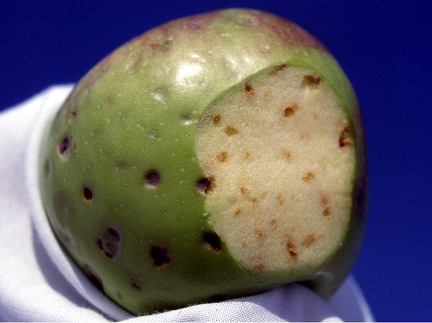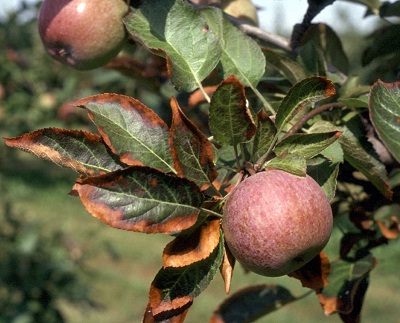Bitter pit control in apples
Learn about bitter pit of apple fruit. Bitter pit is a physiological disorder of apple fruit that can cause serious losses in certain apple varieties.
Introduction
Bitter pit is a physiological disorder of apple fruit that has caused serious losses in certain apple varieties for many years. Spy is frequently affected by this disorder. With the right conditions, bitter pit can occur on Delicious, Idared, Crispin, Cortland, Empire, Honeycrisp and other varieties. The bitter pit sensitivity of some of the newer cultivars is not accurately known at this time. Bitter pit may not be evident at harvest but develops in stored fruit and can result in extensive loss from storage.
General description
Bitter pit is the physiological breakdown of cells under the skin, causing slight depressions generally concentrated at the calyx end of the fruit (Figure 1). The tissue in these depressed areas is darkened, dry and spongy with a bitter taste. In some instances the symptoms may not be apparent on the fruit surface but appear under the skin. Large fruit from trees with light crops are more likely to have bitter pit. Excessive nitrogen (N), potassium (K) or fluctuating soil moisture can cause bitter pit. Calcium (Ca) has an important role in cell wall development. When Ca is in short supply, cell wall integrity is lost, resulting in these symptoms which vary slightly between varieties.

Orchard management
Cultural practices in orchards with a history of bitter pit may be modified to minimize this disorder. Consider the following factors.
Nutritional factors
- Ca nutrition is directly involved in bitter pit development and is discussed later in this factsheet. Other nutrients interact with Ca within the fruit. Upset nutrient balances can result in more serious bitter pit problems.
For example, excessive N causes large fruit that results in a dilution of Ca in the fruit and more serious bitter pit. Apply N fertilizer on the basis of leaf analysis. Excessive N is also indicated by excessive growth and large dark leaves. If N levels are high, reduce the rate of N and in extreme cases, do not apply N fertilizer. Apply N fertilizer as early in spring as possible. Research has shown that applying N after the middle of April increases the incidence of bitter pit.
Excessive K fertilizer applications can also depress Ca in the fruit, particularly when Ca levels are low. Apply K fertilizer only when leaf analysis indicates a need.
Boron (B) is involved in movement of Ca to the fruit. If B is low, Ca disorders such as bitter pit may develop. Be sure there is an adequate B level in the leaves by leaf analysis.
- Pruning can result in higher N levels. If trees are to be severely pruned, reduce the amount of N fertilizer. Moderate annual pruning is best.
- Mulch will even-out soil moisture fluctuations, helping to avoid bitter pit. Do not use mulch materials high in N, such as legume hay. A wide herbicide band with the sod herbicide system of soil management may lead to excessive N and more serious bitter pit problems. The herbicide strip should not extend beyond the spread of the tree branches.
- Excessive fruit thinning or light crops result in large fruit. Annual cropping should be promoted by proper thinning. Apply Ca sprays when the crop is light or the fruit is large.
- Since the disorder develops in storage, loss can be reduced by immediately marketing large fruit or fruit from areas where bitter pit has been a problem.
Calcium nutrition
Bitter pit is closely related to the Ca nutrition of the fruit. Ca is relatively immobile within trees. There can be ample Ca in the leaves and soil but a shortage within the fruit. For this reason, fruit Ca is a much better indicator of potential bitter pit problems than leaf or soil Ca. A gradient of Ca concentrations is found from the stem (high Ca) to the calyx (low Ca) end of the fruit where bitter pit shows first.
Most of the Ca is taken into the fruit by mid-July. From then to harvest, Ca within the fruit is diluted as the fruit increases in size. The larger the fruit the more the dilution, and the more likely there is to be a shortage of Ca. There may even be some export of Ca out of the fruit late in the season. Ca sprays applied to the fruit during this time of fruit enlargement have increased fruit Ca concentrations and reduced the incidence of bitter pit. Soil application of Ca, in contrast, has not been effective in reducing the incidence of bitter pit.
Fruit analysis
Fruit analysis is a helpful indicator of the Ca level within the fruit and the potential risk of bitter pit development in storage. Select 20 average-sized fruit per sample 3 weeks before harvest. Wash samples with distilled water to remove surface Ca deposits. Opposite longitudinal sections, cut from stem cavity to calyx, excluding stems and seeds, are combined to give a sample of apple fruit to be analyzed. Typical optimum analytical values for different cultivars for long-term storage are given in Table 1.
Ca levels should be higher for long-term Ca storage. At high Ca levels, K levels will be less detrimental than at low Ca levels, and in fact may improve fruit quality of certain cultivars. At low Ca levels, high K may depress Ca and result in more bitter pit. The ratio of K/Ca should not exceed 25:1.
| Expressed in mg/100g of fresh weight | N mg/100g | K mg/100g | Ca mg/100g | Mg mg/100g | K/Ca ratio less than: |
|---|---|---|---|---|---|
| McIntosh, Empire, Spy | 30-50 | 70-100 | 4.0-5.0 | 4.0-5.0 | 25:1 |
| Delicious, Crispin, Idared | 40-60 | 100-120 | 4.5-5.5 | 4.5-5.5 | 25:1 |
Timing of calcium sprays
Under Ontario conditions Ca sprays should be applied to the fruit beginning in early July and repeated at 2-week intervals. At least 4 sprays are needed. Where a greater amount of total calcium is required, additional applications can be made by beginning earlier (mid-June) or by continuing applications up until harvest if required. In general, the more Ca applied, the larger the fruit Ca concentrations and the better the bitter pit control. Ca sprays have been applied right up to harvest and even as a dip after harvest.
Caution
With red varieties, the deposit of Ca on the fruit surface resulting from repeated Ca sprays in dry weather, close to harvest, may result in depressed colour development.
The application of foliar sprays of Ca has also been shown to advance fruit maturity. When foliar Ca is being applied fruit maturity should be monitored beginning several days before anticipated harvest.
Coverage
Calcium sprays must contact the fruit for uptake to be effective, therefore water volumes capable of wetting the entire tree are required. If concentrate spraying must be used - apply sprays at 10-day intervals until total amount of calcium is applied.
Sources of calcium
Calcium chloride is perhaps the most economical source of Ca and has given effective control of bitter pit. It can however, cause foliar burning in some cultivars and conditions (Figure 2). Calcium chloride should not be applied at temperatures above 25°C nor under slow drying (high humidity) conditions. McIntosh, Golden Delicious and Idared foliage is very sensitive to calcium and should not be sprayed with calcium chloride.
Commercially calcium chloride is available in flake form (78% CaCl2). This contains 28% elemental Ca. Rates of calcium chloride are shown in Table 2. Do not exceed the concentration shown. Calcium nitrate is another source of Ca that has been used for bitter pit control. Commercial calcium nitrate contains 79% Ca (NO3)2, 19% elemental Ca and 13.5% N.
In orchards well supplied with N, applications of calcium nitrate may result in poor-coloured fruit that does not store well and for this reason should not be used. If N levels are lower, calcium nitrate might be used for the first 2 sprays in July and calcium chloride for the remaining sprays.

Avoid spraying Crispin and Golden Delicious with calcium nitrate, since fruit damage may result. Rates of calcium nitrate are shown in Table 2. Other sources of Ca are available and have been found to control bitter pit provided sufficient Ca is applied.
There is debate as to whether these are more effective per unit of Ca than calcium chloride and calcium nitrate.
Apply at least 20% of the total calcium shown in Table 2. This would require a total of 50 L/ha of 6% Ca (This Ca, OligoCa), 37.5 L/ha of 8% Ca (Liqui-Cal), 30 L/ha of 10% Ca (CaB'y), 25 L/ha of 12% Ca (Stopit), and 17.5 L/ha of 24% CaO (Wuxal). These are total amounts spread over the growing season in 4-5 applications and are minimum amounts.
If conditions are right for bitter pit development, rates could be doubled. These materials can be applied in low volume but sufficient water must be applied to ensure thorough wetting of the fruit and foliage. Check with the manufacturer regarding compatibility with other spray materials. Ca sources should be compared on the basis of cost per unit of Ca.
Be sure to wash the sprayer thoroughly after spraying, since Ca salts are corrosive.
| Time | Calcium kg/ha | Calcium chloride kg/ha/2000L |
Calcium nitrate |
|---|---|---|---|
| Mid-July | 3 | 10 | 15 |
| End July | 3.5 | 12 | 18 |
| Mid-Aug | 4 | 14 | 21 |
| End Aug | 4 | 14 | 21 |
| Total | 14.5 | 50 | 75 |
Compatibility with other spray materials
Calcium chloride or calcium nitrate are compatible with most wettable powders including captan, Guthion and Imidan when sprayed dilute (2000 L/ha). Dissolve the calcium chloride in a pail and thoroughly mix in the spray tank before creaming the wettable powders and adding them. Be sure there is thorough agitation during application.
Sprays containing calcium chloride or calcium nitrate are known to be incompatible with Polyram, magnesium sulfate (Epsom salts), liquid pesticides or emulsifiable formulations, and certain wettable sulfur formulations. If there is doubt concerning compatibility of Ca with pesticides in foliar sprays, consult the manufacturer of the pesticide or use other sources of Ca known to be compatible.
Summary
In summary, the extent and seriousness of bitter pit depends on many factors, including some weather and crop factors outside the grower's control.
However, there are many practices that minimize the extent of bitter pit, reducing fruit loss at harvest and during storage. This increases the return to growers, particularly for varieties prone to developing this disorder. All of these factors should be considered in orchard management to produce high-quality fruit.
Footnotes
- footnote[*] Back to paragraph If lower volumes/ha are used, spray more frequently so that the total amount of Ca is applied during the season. Do not concentrate Ca sprays.
- footnote[**] Back to paragraph Calcium nitrate should not be used in August unless the orchard is deficient in nitrogen.